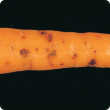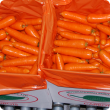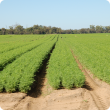Crops
The Department of Primary Industries and Regional Development continues to support the growth and international competitiveness of all crop industries in Western Australia.
With a 2400 kilometre span from its tropical north to its temperate south, WA supports a broad range of cropping industries from rain-fed winter cereals through to irrigated horticultural crops.
In the 2012/13 year the WA cropping industries exported a total of $3.9 billion which comprised: $3.1 billion of cereals, $859 million of pulses, pastures and oilseeds, $142 million of horticultural crops. The major contributors to these exports were wheat ($2.7 billion), canola ($756 million), barley ($377 million), lupins ($42 million), carrots at $48 million, oats ($12 million), and strawberries at $5.5 million.
Articles
Filter by search
Filter by topic
- (-) Remove Pests, weeds & diseases filter Pests, weeds & diseases
- Horticulture (8) Apply Horticulture filter
- Vegetables (8) Apply Vegetables filter
- (-) Remove Carrots filter Carrots
- Diseases (5) Apply Diseases filter
- Pests (3) Apply Pests filter
- Nematodes (3) Apply Nematodes filter
- Potatoes (2) Apply Potatoes filter
- Fungi (2) Apply Fungi filter
- Pumpkin (1) Apply Pumpkin filter
- Tomatoes (1) Apply Tomatoes filter
- Viruses & virus-like (1) Apply Viruses & virus-like filter
- Production & postharvest (1) Apply Production & postharvest filter
- Parsnips (1) Apply Parsnips filter
- Capsicums and chillies (1) Apply Capsicums and chillies filter
- Lettuce (1) Apply Lettuce filter
- Nursery & cutflowers (1) Apply Nursery & cutflowers filter
- Postharvest (1) Apply Postharvest filter













